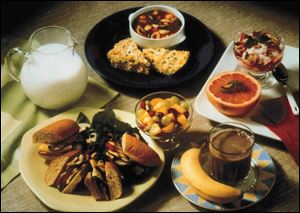
Weight loss may be benefit of DASH diet
10/2/2001Imagine a diet that focuses on what you should eat rather than on what you shouldn't.
Such is the emphasis of the DASH diet. While designed to reduce high blood pressure, a side benefit can be weight loss.
A study from the New England Journal of Medicine confirms that the DASH (Dietary Approaches to Stop Hypertension) diet may help reduce the risk of high blood pressure as much as some medications. High blood pressure affects one in four Americans. If uncontrolled, it can lead to stroke, heart disease, or kidney failure.
The daily DASH diet includes three servings of low-fat dairy foods and eight to 10 servings of fruits and vegetables, as well as low sodium intake. “Three minerals - calcium, potassium, and magnesium - play an important [positive] role in blood pressure,” said Karen Bakies, registered dietitian with the Dairy Council Mid East.

The DASH diet emphasizes low-fat dairy foods, fruits, and vegetables.
These minerals help regulate blood pressure and protect against hypertension. No research suggests that taking high doses of dietary supplements offers any extra benefits, according to the American Dietetic Association. Foods high in fat and sodium, caffeine, and alcohol have been found to contribute to high blood pressure.
It's the food that counts. Daily portions in a 2,000-calories-per-day menu include:
Weekly portions include:
It isn't that difficult to eat eight to 10 fruits and vegetables a day. “A whole banana is two servings of fruit,” said Mrs. Bakies. “People need to understand what portion sizes are.”
Start small. Make a few changes at a time. Add a serving of vegetables at lunch and another at dinner. Add a serving of fruit to your meals or have one as a snack. Both add fiber to your diet.
“Fiber plays a role in losing weight,” said Mrs. Bakies. “When you lose weight, your blood pressure goes down. Eating foods with fiber makes you feel full sooner.”
For people who don't like dairy products, sneak milk into soups and hot cereals. Choose milk-based desserts, such as low-fat puddings. This boosts intake of calcium and minerals.
Instead of soda, alcohol, or sugar-sweetened tea, drink low-fat milk with lunch and dinner.
Treat meat as one part of the whole meal instead of the focus. Try more casseroles, pastas, and stir-fries, which include lots of vegetables, but watch that portions are not platefuls.
This concept is the opposite of the high-protein diet that many people use today. “Less servings of meat follow the Food Guide Pyramid, which the DASH diet is patterned after within the serving amounts recommended,” said Mrs. Bakies. “The real key is portion sizes.”
Kathie Smith is The Blade's food editor. E-mail her at food@theblade.com.